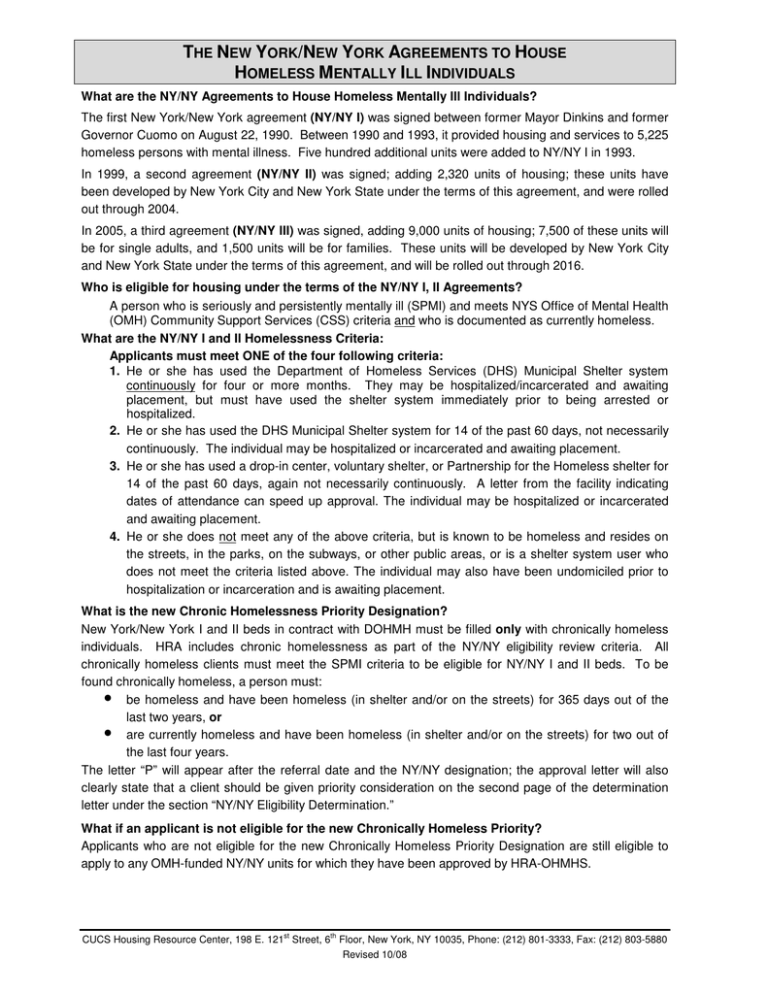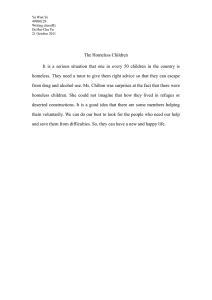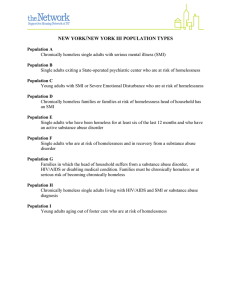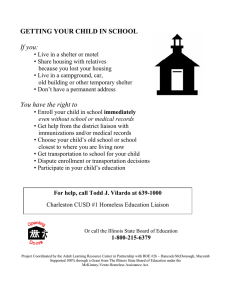NY/NY I and II Eligibility - Center for Urban Community Services
advertisement

THE NEW YORK/NEW YORK AGREEMENTS TO HOUSE HOMELESS MENTALLY ILL INDIVIDUALS What are the NY/NY Agreements to House Homeless Mentally Ill Individuals? The first New York/New York agreement (NY/NY I) was signed between former Mayor Dinkins and former Governor Cuomo on August 22, 1990. Between 1990 and 1993, it provided housing and services to 5,225 homeless persons with mental illness. Five hundred additional units were added to NY/NY I in 1993. In 1999, a second agreement (NY/NY II) was signed; adding 2,320 units of housing; these units have been developed by New York City and New York State under the terms of this agreement, and were rolled out through 2004. In 2005, a third agreement (NY/NY III) was signed, adding 9,000 units of housing; 7,500 of these units will be for single adults, and 1,500 units will be for families. These units will be developed by New York City and New York State under the terms of this agreement, and will be rolled out through 2016. Who is eligible for housing under the terms of the NY/NY I, II Agreements? A person who is seriously and persistently mentally ill (SPMI) and meets NYS Office of Mental Health (OMH) Community Support Services (CSS) criteria and who is documented as currently homeless. What are the NY/NY I and II Homelessness Criteria: Applicants must meet ONE of the four following criteria: 1. He or she has used the Department of Homeless Services (DHS) Municipal Shelter system continuously for four or more months. They may be hospitalized/incarcerated and awaiting placement, but must have used the shelter system immediately prior to being arrested or hospitalized. 2. He or she has used the DHS Municipal Shelter system for 14 of the past 60 days, not necessarily continuously. The individual may be hospitalized or incarcerated and awaiting placement. 3. He or she has used a drop-in center, voluntary shelter, or Partnership for the Homeless shelter for 14 of the past 60 days, again not necessarily continuously. A letter from the facility indicating dates of attendance can speed up approval. The individual may be hospitalized or incarcerated and awaiting placement. 4. He or she does not meet any of the above criteria, but is known to be homeless and resides on the streets, in the parks, on the subways, or other public areas, or is a shelter system user who does not meet the criteria listed above. The individual may also have been undomiciled prior to hospitalization or incarceration and is awaiting placement. What is the new Chronic Homelessness Priority Designation? New York/New York I and II beds in contract with DOHMH must be filled only with chronically homeless individuals. HRA includes chronic homelessness as part of the NY/NY eligibility review criteria. All chronically homeless clients must meet the SPMI criteria to be eligible for NY/NY I and II beds. To be found chronically homeless, a person must: • be homeless and have been homeless (in shelter and/or on the streets) for 365 days out of the last two years, or • are currently homeless and have been homeless (in shelter and/or on the streets) for two out of the last four years. The letter “P” will appear after the referral date and the NY/NY designation; the approval letter will also clearly state that a client should be given priority consideration on the second page of the determination letter under the section “NY/NY Eligibility Determination.” What if an applicant is not eligible for the new Chronically Homeless Priority? Applicants who are not eligible for the new Chronically Homeless Priority Designation are still eligible to apply to any OMH-funded NY/NY units for which they have been approved by HRA-OHMHS. CUCS Housing Resource Center, 198 E. 121st Street, 6th Floor, New York, NY 10035, Phone: (212) 801-3333, Fax: (212) 803-5880 Revised 10/08 THE NEW YORK/NEW YORK AGREEMENTS TO HOUSE HOMELESS MENTALLY ILL INDIVIDUALS (CONTINUED) What categories of eligibility fall under the terms of the NY/NY III agreement? The following populations will be considered under the NY/NY III Agreement; eight of the nine categories are currently operational: • • • • • • • • • Chronically homeless single adults who suffer from serious and persistent mental illness or who are diagnosed as mentally ill and chemically addicted (MICA). Single adults who are presently living in New York State-operated psychiatric centers or State-operated transitional residences and who could live independently in the community if provided with supportive housing and who would be at risk of street or sheltered homelessness if discharged without supportive housing. Chronically homeless single adults who are persons living with HIV/AIDS (who are clients of the HIV/AIDS Services Administration or who are clients with symptomatic HIV who are receiving cash assistance from the City) and who suffer from a co-occurring serious and persistent mental illness, a substance abuse disorder, or a MICA disorder. Chronically homeless families, of families at serious risk of becoming chronically homeless, in which the head of the household suffers from a substance abuse disorder, a disabling medical condition or HIV/AIDS. Chronically homeless single adults who have a substance abuse disorder that is a primary barrier to independent living and who also have a disabling clinical condition (i.e., a medical or mental health condition that further impairs their ability to live independently). Homeless single adults who have completed a course of treatment for a substance abuse disorder and are at risk of street homelessness or sheltered homelessness and who need transitional supportive housing (that may include half-way houses) to sustain sobriety and achieve independent living. Young adults, ages 18-24, who have serious mental illness being treated in New York State licensed residential treatment facilities, State psychiatric facilities or leaving or having recently left foster care and who could live independently in the community if provided with supportive housing and who be at risk of street or sheltered homelessness if discharged without supportive housing. Chronically homeless families, or families at serious risk of becoming chronically homeless, in which the head of the household suffers from a serious and persistent mental illness of a MICA disorder. Young adults (aged 18 - 25) leaving or having recently left foster care or who had been in foster th care for more than a year after their 16 birthday and who are at risk of street homelessness or sheltered homelessness. How do I document and obtain NY/NY I, II and/or III eligibility? Submit the HRA 2010e electronically to HRA Office of Health and Mental Health Services (OHMHS). Any history of homelessness should be indicated in the Housing/Homeless Table, as well as in the Clinical Assessment: Axis IV section of the HRA application. In addition, all housing information should be explained in detail in the attached Housing Psychosocial summary or Mental Health Report. Whenever possible, document information regarding places stayed, dates, services used, etc. Mental Illness should be documented in Clinical Assessment section of the HRA application and in the attached Psychiatric Summary or Mental Health Report. Questions about NY/NY Eligibility, Electronic Filing of the HRA application or the new Chronic Homelessness Priority? Please call CUCS at (212) 801-3333. CUCS Housing Resource Center, 198 E. 121st Street, 6th Floor, New York, NY 10035, Phone: (212) 801-3333, Fax: (212) 803-5880 Revised 10/08






